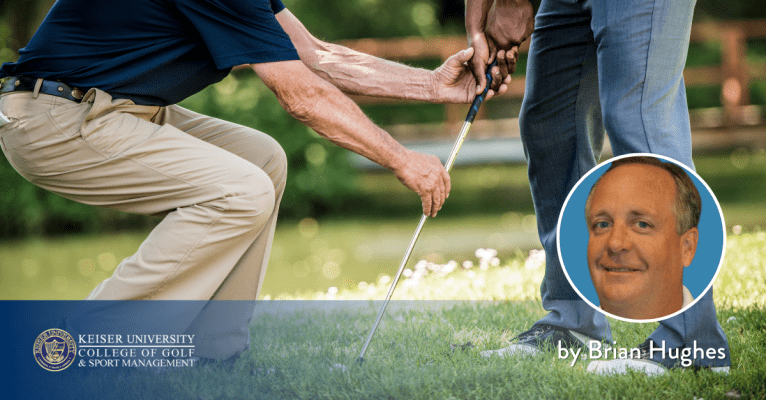The Importance of Feedback in Golf Instruction

By Brian Hughes, Keiser University College of Golf Program Director and PGA Master Professional
A common misconception for golfers is the idea that if you take a golf lesson, the golf professional can “fix” you. If only it were that easy! Apparently, the assumption is that with just a few tweaks, the player can improve their performance immediately, just like taking your car to the shop and expecting the mechanic to have it repaired and ready to run. Unfortunately, improvement in golf does not happen that way. It takes time and effort on the part of the golfer. With the guidance of a qualified golf instructor, this time frame can be shortened but this requires their combined efforts, hence the importance of multiple forms of feedback.
Types of Feedback in Golf
Extrinsic Feedback
One of those forms of feedback is extrinsic feedback. This comes from external sources such as friends, playing partners, teammates, and coaches. Most commonly, these are verbal comments or visual suggestions that occur after a shot, round, etc. While these can be helpful, an obvious concern has to be the knowledge level of the source of feedback. If the source is knowledgeable about the subject matter, it can help the player identify and problem-solve. If done properly, the individual providing the guidance knows how much help to provide and at the proper time, in addition to using proper information that is not simply relevant to them personally. Ideally, the source can instruct the player to learn to help themselves, a valuable skill in playing an individual sport.
Intrinsic Feedback
Intrinsic feedback is gathered from the player themselves, based on sensations in their body, such as balance or a change in movement patterns as they attempt to execute a golf-related skill. There are considerable advantages to intrinsic feedback, including its immediacy, that it is self-detected, and can be rapidly adjusted during a round, especially the more skilled and experienced the player is. Unfortunately, there are some deterrents to its sole use, primarily for beginning golfers who likely need more guidance.
Augmented Feedback
Receiving feedback on performance results or techniques from an external source is referred to as Augmented Feedback. With this form of feedback, usually from a coach or knowledgeable source, the information is likely new information to the athlete or perhaps is gathered from sources they are not familiar with. An excellent source of results-based augmented feedback comes from statistical analysis, which can help in recognizing player strengths and weaknesses. With this information, in the short term, a player can strategize to minimize weakness and maximize strength, and in the long term, they can be ensured they are working to improve in the correct performance areas.
Kinematic Feedback
If a player is working on a swing change, they are learning through kinematic feedback. This type of feedback is a type of knowledge of performance feedback and is used to guide learning or adjustment of motor skills. In golf, the improvement of the quality of the golf swing and the cause-and-effect results of the movement change are measured and monitored through kinetic feedback.
Internal Feedback
When it comes to the results of a golf shot, the golfer will view them as either positive or negative. Internal feedback relative to the swing normally comes from a solid feeling of the ball coming off of the face of the club or in terms of the player’s balance during the swing, most apparent in their finish position.
Regarding the results of the shot, obviously, a positive feeling comes from solid contact with the ball and the resulting ball flight heading in the desired direction and landing the predicted distance from the target. If that did not happen, the golfer would likely be unhappy and view the shot negatively. This labeling of golf shots as either good or bad is quite obvious; however, it is not necessarily helpful unless more precise feedback is received.
For example, when the golfer informs their instructor they hit it bad, what exactly made it bad? Obviously, the player is unhappy with the result, but was the shot short or long of the target? Was it right or left of the target? Did it start in one direction and curve in another, or did the ball fly fairly straight? Was the shot too high in the air or too low? What happened when it landed – did it stop too quickly, or did it not stop quickly enough? If the shot was mis-hit on the face, was contact on the toe, heel, bottom, or top of the club? Plenty of questions to be asked but the answers provide more precise feedback that can help the player and instructor take corrective action should there be a distinctive pattern to the results.
External Feedback
When it comes to External Feedback, the golfer receives it in many forms. Verbal feedback comes from the instructor or playing companions. When the coach states that the player made a proper or improper movement or provides solutions or recommendations for improving performance, they are providing verbal feedback. For the professional golfer, verbal feedback oftentimes can come from crowd reaction to a golf shot, such as cheering the results, or in the case of a bad result, the groan or silence from the gallery can speak volumes.
Visual feedback is quite obvious in golf, mostly gained from the golf ball itself. The joy felt from seeing the ball head toward its target has kept golfers engaged in the game since the beginning of time. On the opposite, the disappointment felt by golfers as they see their shots go wayward has kept golf instructors employed for just as long. Learning to read and understand why a ball flies the way it does is an important part of learning from this feedback, as understanding cause and effect relationships related to ball flight and club movement is an important element of a golfer becoming more self-sufficient with their game.
Visual feedback has become even more advanced and potentially beneficial as technology has made video recordings of golfer techniques available to the masses. This type of visual feedback can allow the golfer to understand better areas of their swing that relate to proper club movement and golf shot results. In the hands of a qualified instructor, video is a tool that can save time and help the instructor prioritize areas of the swing the golfer can adjust to enhance performance. In recent years, video analysis using three-dimensional capabilities has enhanced the quality of diagnosis available to the instructor.
Staying in the area of technology, feedback received from data collection has become even more prevalent in golf instruction than ever before. On the course, statistical analysis of shot results is more advanced than ever before through the use of GPS systems and shot tracking applications. Where the player is gaining and losing strokes can now be tracked in all areas of the game, helping the player and instructor hone in on areas in which to focus improvement.
Off the course, launch monitors are now a critical tool for players and instructors alike. The effects of a technique change can now be accurately measured in terms of effectiveness in addition to witnessing a change in ball flight. If a player desires to hit the ball farther, for example, using calculations from the launch monitor that measures the quality of contact, club head speed, club movement, and resulting ball speed can be optimized to the player’s benefit. The use of this equipment can also help with the proper fitting of golf clubs for the player, making it easier for the instructor to find the correct matchups of player capability and equipment to maximize performance.
Benefits of Feedback in Golf
It has been said that the first step to solving a problem is recognition of the problem! As the golfer builds this awareness, they are recognizing one of the biggest benefits of feedback, as it is step one to correct the issue. Simply saying that you don’t putt well is a starting point, but being able to diagnose the “why” behind the disappointing results can lead to corrective action.
The ideal process for correcting mistakes and then making the proper adjustments in technique starts with the ability to read and understand the feedback the golf ball provides. Knowledge of the laws of ball flight and the factors that determine what makes it fly in its intended direction and at the desired distance is the starting point of improved performance. In other words, if the ball is doing what the player intends consistently and predictably, is their technique not sufficient? The only reason to change technique is to improve the golfer’s skill at creating the desired ball flight relative to distance and direction control or to improve the consistency of this skill. As this skill is measured and monitored over time, the reinforcement of the technique used is developed.
Given the many challenges of the game of golf, both physically and mentally, the psychological benefits of correct feedback in golf are almost endless. With correct feedback, the golfer can learn new skills and enhance current skills in the four main areas of golf improvement: technique development, mental skill development, proper equipment usage, and physical fitness.
Performance feedback can also help to motivate the golfer. As their skills improve, the golfer’s desire to continue to work on these skills builds as well. The positive feedback gained from improvement serves as a motivator (as do lower scores!) that supports their efforts to date.
As scores lower and competence improves, so does the player’s confidence. Players learn that they are working on the correct aspects of their game, and the results are showing, leading to more confidence, which will suit them well under pressure. As the golfer feels they have put in the work to improve and have seen positive results, this translates to better performance on the course.
While the player’s confidence in their performance grows, this can also lead to an even more important aspect of confidence, which is in the area of personal confidence. Personal confidence is one’s belief in oneself over and above one’s performance in a given endeavor. While in sports performance, confidence can tend toward ups and downs over time, a person’s belief in themselves, based on past performance, work ethic, and the processes that led to that performance in the past, will guide them in the belief that t they will be back on track soon.
Effective communication between a coach and a golfer can help golfers use feedback to improve their game. A good coach will provide constructive feedback that’s tailored to the golfer’s needs.
Role of Self-Feedback and Self-Reflection
It has been said that we never quite own our golf swings but we simply rent them! As the game of golf is a mentally challenging sport that requires a balance between the mind and body, the skill or ability to keep it in perspective is an important one. The ability to have honest feedback from yourself and to understand the importance of goal setting for future growth can help the golfer maintain focus and motivation in an activity that is impossible to master completely.
In an activity as challenging as the game of golf, it is important to remember where you were at one point on the improvement journey. As players work on skill building, they can improve quite quickly. However, they can also tend to forget how quickly they improved and may think that the learning curve will continue to rise at the same rate.
For instance, a beginning golfer may quickly improve their score from well over 100 to breaking that barrier in a short period. Through practice, experience, the guidance of an instructor, and time, they improve at a remarkable rate. However, as each scoring barrier confronts them, the challenge of breaking through that barrier becomes greater, which can lead to frustration. The ability to reflect on where they were and where they are, and the effort it took to get there, can help the golfer be patient through these challenging times.
It is also important for the golfer to set goals for themselves, as this is a key to performance improvement. Setting goals is a key to success in all endeavors, but these goals do need to be logical and may require the guidance of the golf instructor. Making sure goals are specific and can be measured is critical and needs to be precise in all areas, from driving to putting. Wanting to “get better” is too vague (and obvious) to be a functional target.
Improvement in specific areas numerically, be it handicap or scoring, leads to the knowledge your process is working or may need adjustment. This process focus is vital as the golfer tries to get better because the more improvement that takes place, the harder it can be to recognize that it is taking place. The golfer who drops their handicap from a 30 to a 15, has improved a tremendous amount. The golfer who drops their handicap from a 2 to a 1 has improved by the same percentage, just not the same number of strokes!
Learn more!
Want more tips? If you want to take your game to the next level, contact our team at Keiser University’s College of Golf & Sport Management today. With our dedication and experience, we can elevate your game to new heights together. Give us a call today at 888-355-4465.














